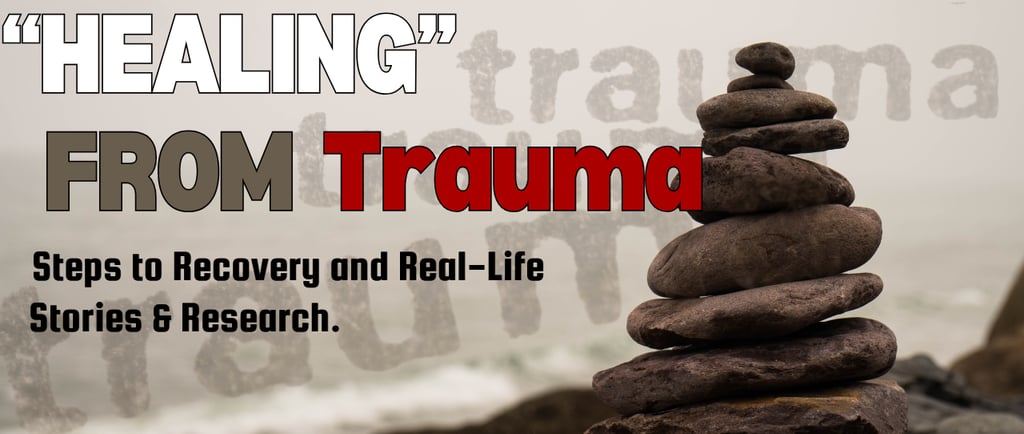Healing from Trauma: Steps to Recovery and Real-Life Stories
Learn how to rebuild trust after trauma with proven steps, inspiring stories, and expert-backed strategies. Heal yourself and reconnect with others safel
TRAUMA & HEALING
Team Fossoria
7/29/20256 min read


Healing from trauma is a journey – one that millions of people around the world are undertaking every day. Consider the story of Samira, a young woman from Bangladesh who endured traumatic experiences in her childhood. For years, she struggled with nightmares, trust issues, and anxiety. She often wondered if she could ever feel “normal” again. Samira’s story is just one example of how deeply trauma can affect someone, but also how hope and healing are truly possible. In fact, approximately 70% of the world’s population has been exposed to a traumatic event in their lifetime. If you have experienced trauma, you are far from alone, and with the right support and strategies, you can heal.
Understanding Trauma and Its Impact
Trauma isn’t “all in your head.” Scientific research reveals that trauma doesn’t just affect emotional health; it can rewire neural pathways in the brain, leading to lasting changes in thought patterns and responses. These changes explain why painful memories and reactions can linger long after the traumatic event. Trauma can also lead to serious mental health challenges like post-traumatic stress disorder (PTSD), depression, or anxiety. For example, a study of survivors of a major cyclone in Bangladesh found that 25% developed PTSD and many others experienced depression or anxiety disorders. This shows how a harrowing experience can leave deep psychological scars. Understanding the real, physical impact trauma has on the brain and body reminds us that healing is not as simple as “just forget it and move on.” It requires compassion and deliberate care.
Unfortunately, one of the biggest hurdles to healing – especially in places like Bangladesh – is the stigma around mental health. Strong levels of stigma and a lack of awareness in Bangladesh have been identified as barriers to accessing mental health care. Samira, for instance, initially hid her suffering. She felt ashamed and feared people would label her “weak” or “crazy” for seeking help. Such stigma can make trauma survivors feel isolated. However, acknowledging the trauma and understanding its impact is the first step toward recovery. It’s important to realize that needing help after trauma is normal – trauma is an injury, and like any injury, it needs treatment. No one should feel guilty for struggling with the aftermath of terrible events.
Steps and Strategies for Healing from Trauma
Recovering from trauma is a gradual process with ups and downs. It helps to break the journey into manageable steps. Here are some key steps and strategies that trauma survivors (including Samira) have found useful on the road to healing:
Acknowledge the Trauma and Your Feelings: Healing begins by facing what happened and accepting that it did affect you. Give yourself permission to feel pain, grief, or anger about the trauma. This might involve journaling about your experience or talking to a trusted person. Remember that your reactions – nightmares, fear, sadness, anger – are valid responses to abnormal events. You survived something very difficult, and it's okay not to be okay at first.
Seek Support – You Are Not Alone: Connecting with others is incredibly healing. Trauma can make people want to withdraw, but support from friends, family, or support groups can provide comfort and understanding. Consider confiding in someone you trust about what you’re going through. There are also trauma support groups (in person or online) where survivors share experiences and coping strategies. When survivors come together, healing becomes a shared journey rather than a solitary struggle. Samira, for example, found a women’s support circle in Dhaka where others had gone through similar childhood abuse. Hearing “me too” from peers helped her feel less alone and more hopeful. Community support not only eases isolation but also rebuilds a sense of belonging and self-worth that trauma often shatters.
Consider Professional Help (Therapy): Trauma-focused therapy can be life-changing. A trained therapist can provide a safe space to process what happened and teach you tools to cope. Different therapies work for different people – some may talk through their trauma, others might try creative therapies or body-focused methods. One highly effective approach is Eye Movement Desensitization and Reprocessing (EMDR), a therapy designed for trauma. Research shows EMDR can significantly reduce trauma symptoms in a short time. For instance, up to 100% of single-event trauma survivors and 77% of those with multiple traumas had no PTSD symptoms after only six sessions of EMDR therapy. This doesn’t mean every person will have identical results, but it highlights that healing is possible with proper treatment. Don’t hesitate to reach out to a psychologist or counselor, even if it’s via telehealth or a local clinic. In Bangladesh, mental health services are growing, with professionals trained to help trauma survivors (though access can be a challenge). If cost is an issue, look for NGOs or community organizations that offer counseling. The key is: you do not have to carry this burden alone.
Develop Healthy Coping Skills: Alongside therapy or support, it’s important to find day-to-day coping techniques that help you feel safe and calm your mind and body. Trauma often throws your nervous system into constant “alarm mode.” Grounding and relaxation skills can help reset your sense of security. For example, deep breathing exercises, meditation, or prayer can reduce anxiety in moments of. Physical activity is another proven tool – even a short walk or some simple stretches release tension. Some people find solace in creative outlets like drawing, writing poetry, or music to express feelings that are hard to talk about. Keeping a routine (like regular sleep and meal times) and eating healthy food can restore a sense of normalcy and strengthen your resiliency. Everyone is different, so experiment with what works for you. Samira started practicing mindfulness meditation and noticed it helped calm her flashbacks. She also carried a small object (a smooth stone) in her pocket – whenever she felt overwhelmed by traumatic memories, she held it and described its texture to herself. This simple grounding technique brought her back to the present moment when past fears surged. Over time, these small coping skills add up and give you a sense of control over your trauma responses.
Practice Self-Compassion and Patience: One of the hardest parts of healing can be dealing with your own inner critic. Trauma can make people feel “broken” or blame themselves for what happened (“I should have been stronger,” “It’s my fault”). In reality, no one who experiences trauma is at fault for it. Being kind to yourself is crucial. Remind yourself that you’re surviving and trying your best. If you find you’re mentally beating yourself up, pause and ask: Would I blame a dear friend if this happened to them? Of course not – you would offer them kindness. You deserve the same. In fact, trauma recovery is about nurturing and growing your capacity for self-compassion, trauma-informed.ca. Studies have found that increasing self-compassion helps reduce shame and emotional pain in trauma. Try to treat yourself as gently as you would a loved one. This might mean allowing yourself to cry without judgment, writing yourself an encouraging note, or engaging in soothing self-care like a warm bath or a favourite hobby. Also, be patient: healing doesn’t happen overnight. There will be good days and bad days. Sometimes it may feel like you’re taking two steps forward, one step back – and that’s okay. Healing is not a straight line, but with time, the bad days do gradually lessen. Every small step counts, whether it’s sleeping a bit better, or going a week without a panic attack, or feeling joy again for the first time in a while. Celebrate those wins. You are rebuilding yourself, and that deserves compassion and credit.
Moving Forward: Hope and Growth After Trauma
It’s important to know that healing is not just about returning to “how things were before.” Many people find that through the struggle, they discover new strength, meaning, or direction in life – a concept known as post-traumatic growth. Research has found that over half (about 52%) of people report moderate to high levels of positive personal growth after going through adversity. This growth can take different forms: some develop a deeper appreciation for life, some strengthen their relationships or faith, and others, like Samira, decide to help others who suffered similar trauma. After months of therapy and support, Samira’s nightmares finally eased. She gradually rebuilt her confidence. Today, she volunteers with a local community organization to raise awareness about child abuse and to support young girls in need – turning her pain into purpose. As she puts it, “I can’t change what happened to me, but I can choose what I do with it now.” Her journey shows that while trauma may always be a part of your story, it does not define your future.
In conclusion, healing from trauma is absolutely possible. It may be one of the hardest things you ever do, but you will get stronger along the way. Remember that you are not alone – reach out for the support you deserve, whether from loved ones, support groups, or professionals. Take it one day at a time, and take care of yourself with the same compassion you’d give to a friend. Your feelings are valid, your experiences matter, and with time and support, the pain can lessen. You can reclaim control of your life from trauma’s grip. Just like countless others who have walked this path, you too can move from survival to strength, and write a new chapter defined not by what hurt you, but by how you healed. Hope and healing go hand in hand – and both are within your reach.
Valuable References (For Credibility & Further Reading)
Herman, J. L. (1992). Trauma and Recovery. Basic Books.
van der Kolk, B. (2014). The Body Keeps the Score: Brain, Mind, and Body in the Healing of Trauma. Penguin Books.
American Psychological Association (APA). Trauma and PTSD Resources
Verywell Health. Cognitive Processing Therapy for Trauma
PMC National Library of Medicine. Trauma Recovery and Post-Traumatic Growth Studies
Clamon Counseling. Feeling Safe After Trauma
The Wellness Society. How to Rebuild Trust as a Trauma Surviv
